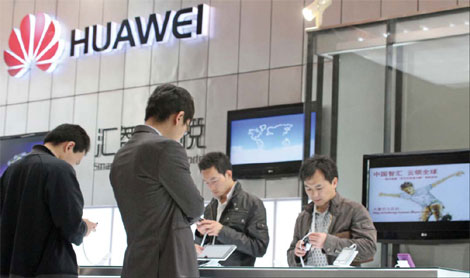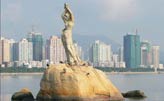Huawei longs for breakthrough in US
Updated: 2011-09-09 08:32
By Ariel Tung (China Daily)
|
|||||||||
|
|
In an economy where companies are cutting down on costs and moving slowly to hire new workers, Huawei Technologies Co Ltd is growing steadily.
In April, Huawei, the world's second-largest telecommunications equipment supplier, opened a new research and development center in Santa Clara, Calif, in an expansion of its 10-year presence in the United States.
The Santa Clara center, a 200,000-square-foot facility, is Huawei's North American R&D headquarters and has more than 500 employees.
The company also recently revamped its R&D facility in Bridgewater, NJ. The New Jersey center began as a 9,000-square-foot facility with four employees in 2008 and has grown into a 36,000-square-foot center with more than 110 employees. Miguel Dajer, who heads the new center and is Huawei's vice-president of wireless R&D in the US, says he plans to increase the center's headcount by at least 50 percent over the next three years.
Dajer says the new center is "a real launch of a professional facility that can make Huawei more competitive".
The new expansion achievements point not only to the company's successful model of growth but also to its perseverance at a time when it has been the center of controversy.
Within the past few years, it has encountered a number of complaints from the United Kingdom and the US governments that its plans to merge with or purchase US- or UK-based companies pose threats to each nation's national security.
"We have been here for 10 years. We are very patient. We believe our solutions are of the best quality. We are confident that we will have total success in this market," says William Plummer, vice-president of external affairs.
The recent expansion moves are also remarkable considering its humble beginnings.
Based in Shenzhen, South China's Guangdong province, the company began more than two decades ago selling landline phone parts from Hong Kong to the mainland. By the early 1990s, the company was producing its own landline phone parts.
In 2001, Huawei USA was established on US soil in Plano, Texas. Since that time, Huawei's US operations have grown to 1,500 employees in 12 offices and seven R&D centers. The company made $772 million in US revenue last year.
This year, Huawei has added 500 workers to its US payroll "in anticipation of its fast and continuous growth in the US", says Plummer, adding that local employees make up more than 75 percent of the company's labor force.
The New Jersey facility is slated to be Huawei's North American hub for wireless technologies. Plummer says New Jersey is an ideal location for an R&D center because the state is known for its communications and transportation network technologies. Companies such as Verizon and Alcatel-Lucent have chosen the state as the home for their offices.
Research and development is a main component of the company's strategies. Of the $28 billion in global revenue last year, $2.6 billion was spent on R&D, which is a 24-percent increase in R&D spending from 2009. Approximately half of its 110,000 employees worldwide are engaged in R&D.
According to Huawei, the company's investment in R&D activities in the US has grown by an average of 66 percent per year, reaching $62 million last year.
One area of research Dajer and his team are working on is the congestion of mobile phone networks. After the 5.8-magnitude earthquake that struck Virginia on Aug 23, Dajer says millions of people tried to make phone calls or send text messages, creating a network clog.
"The amount of space for transmission is limited. We are doing research on congestion control and how to maximize the space for transmission," Dajer says.
Huawei is also focused on minimizing the impact of "signaling storms" which involves network congestion and the deterioration of network service quality induced by the increasing number of smartphone users.
Besides providing network technologies and equipment for telecommunications operators, Huawei also produces and sells a variety of devices under its own name, such as the IDEOS smartphone and tablet PC.
More than half of the company's US revenue in 2010 came from the sales of devices according to the company. Last year, Huawei shipped 120 million units around the world, out of which 30 million were handsets. Huawei's global sales of handsets surpassed those of Motorola and HTC, according to US-based ABI Research.
Wan Biao, CEO of Huawei's handheld devices division, wants the company to be one of the world's top three mobile handset brands by 2015, according to the Financial Times, despite the fact that Huawei is not a well-known consumer brand.
But this may soon change. Huawei officials say the company plans to launch its own Android-driven smartphone called the Huawei Vision. Wan says the company hopes to sell 20 million smartphones globally this year. ABI Research said the smartphones could give Huawei the global breakthrough it is hoping for, though the company would need to strike an infrastructure deal with either Verizon Wireless, AT&T, Sprint or T-Mobile. Plummer says the company is having an ongoing dialogue with many mobile phone operators in North America.
But Huawei has been the subject of a different kind of dialogue in the past three years. Last year, Huawei was asked to revoke its deal to buy patents and hire employees from 3Leaf Systems, a California-based cloud-computing company. According to The Wall Street Journal, the Pentagon demanded Huawei retroactively seek approval of the transaction from the Committee on Foreign Investment in the United States (CFIUS), which reviews foreign investments that pose threats to national security.
The episode was a rerun of Huawei's canceled deals, such as its bid to buy 3Com Corp in 2008 and a deal to buy Sprint Nextel Corp's network in 2010. That the company's founder, Ren Zhengfei, was an engineer for the People's Liberation Army in the early 1980s, which has stoked fears that there are links between the company and China's central government.
Huawei has since made efforts to dispel misunderstandings about the company's corporate structure and alleged ties to the government and military. In a detailed and forthcoming letter, Ken Hu, Huawei's deputy chairman, addressed questions over the company's ties to the Chinese government and military and even challenged the US government to launch an investigation into any security concerns it may have with the company.
(China Daily 09/09/2011 page16)












